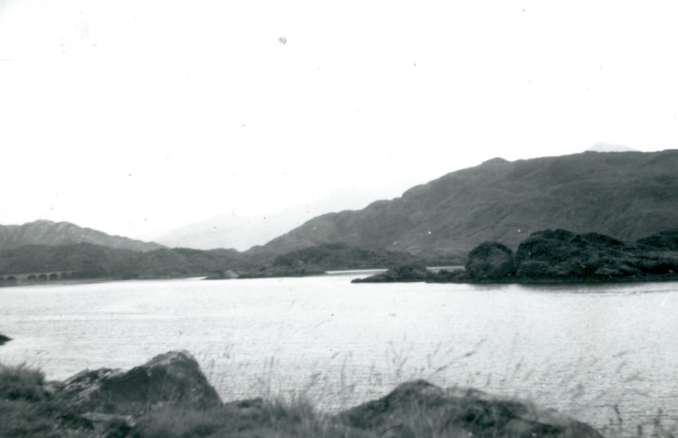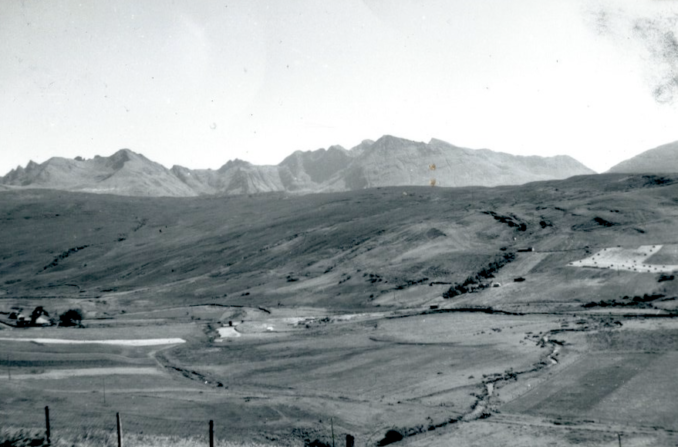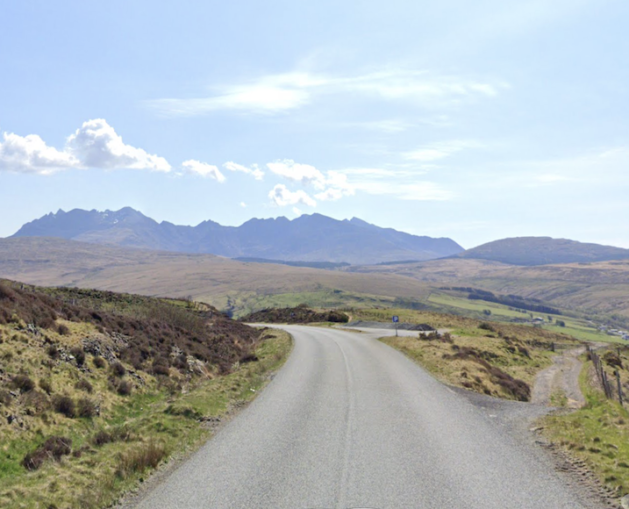Loch Ailort
As we accompany my grandparents (and their caravan) on their 1956 Scottish road tour, we reach Loch Ailort, a west coast sea loch and popular tourist destination. Or do we?
The location of the photograph captioned ‘Loch Ailort’ in our family album is easy to find once you realise; A, it isn’t Loch Ailort and B, a row of trees pictured against a field to the right are, in fact, the arches of a viaduct. A layby on the A830, also known as the Road to the Isles, on neighbouring Loch Nan Uamh is without a doubt where my grandparents actually took the photograph. Compare the craggy islands, hilly horizon and distant viaduct in the two photos. You can have a look around via this link.

© Always Worth Saying 2023, Going Postal

© Google Street View 2023, Google.com
The layby is for the convenience of visitors to the Prince’s Cairn, attached to which is the following inscription, in Gaelic above English,
“This carin marks the traditional spot from which Prince Charles Edward Stuart embarked for France on 20th September 1746”
In the symmetry of such things, in last week’s episode we visited the Genfinnan Monument which marked the arrival of the Young Pretender on the shore of nearby Loch Shiel.
Might there have been a family interest in this fascinating piece of history? As further evidence, if it were needed, that few degrees of separation lie between all things, my grandfather’s great-great-grandfather was born in 1744 not a spit away from where Bonnie Prince Charlie and his rebel army invaded England and found our local garrison somewhat underprepared.
Reading between the lines of the fevered contemporary newspaper reports one can’t help but suspect, the Pretender’s army having arrived on market day, my fellow Carlislians, as befits inhabitants of a Debatable Land and being of a simple country stock, took great pleasure and profit in selling the invading army anything they required, even ladders to assist in the storming of their own city and castle walls.
The dates contained within our family tree and family Bible (albeit often wrong and proveably so thanks to an alarming recent DNA test), suggest my grandfather’s grandfather could have sat on his own grandfather’s knee and heard the story from one who was alive on that very day in that very place.
Perhaps a passed down tall tale of derring-do, slightly exaggerated and mildly embellished, for which the Worth-Sayings are noted, drew my grandparents to that forbidding coast?
That viaduct is the Loch Nan Uamh Viaduct which is built of concrete and has eight arches spanning 50 feet each, crossing over the Allt a’ Mhama, which flows into Loch Nan Uamh. The viaduct was constructed by Robert McAlpine & Sons with Simpson & Wilson as engineers. Robert McAlpine’s son, also Robert, headed the construction. The viaduct is also known as the Gleann Mama Viaduct and is one of six on the 41-mile-long West Highland line between Fort William and Mallaig. In 2001, a Mr Roland Paxton aided by radar equipment discovered the remains of an entombed horse and cart, the victims of a mishap during construction, within the central pylon of the viaduct.
Although not having photographed Loch Ailort, the tourists will have passed along its northernmost shore and through the hamlet of Lochailort en route from Glenfinnon to the cairn. Besides its own halt on the West Highland line, Lochailort boasts Inverailort House requisitioned by the military during the war and used to train irregular forces as the Special Training Centre. According to wiki,
Many techniques of guerrilla and irregular warfare were developed there and training techniques which were adopted for Commando training at Achnacarry Castle. SOE [Special Operations Executive] training was centred on nearby Arisaig House.
The army moved out of the house on 20 August 1942 and, after having been taken over by the Royal Navy, subsequently became HMS Lochailort and was used for the training of naval cadet ratings to be officers on small craft used by Combined Operations. The Royal Navy moved out in January 1945.
The Cuillins of Skye

© Always Worth Saying 2023, Going Postal
The connection with Bonnie Prince Charlie continues as we reach Syke. The Young Pretender’s escape to the western isle is a fascinating tale of adventure and intrigue. After his defeat at the Battle of Culloden on April 16th 1746, the prince was forced to flee for his life. With the help of loyal supporters and with a £30,000 bounty on his head, the Pretender managed to evade capture and make his way to the Isle of Skye, where he hid until September when he was picked up from the site of the cairn. Aboard the French frigate L’Heureux, Charles Edward Stewart returned to France and resumed a life of mistresses, Popery and the bottle until dying of a stoke in 1788, aged 67.
As for Syke, it is the second-largest island in Scotland after Lewis & Harris, with an area of 639 square miles. It is a popular tourist destination known for its stunning landscapes, rich history, rugged terrain and wildlife such as golden eagles and red deer. Skye is also a world-class destination for walkers and climbers, offering challenging climbs and interesting scrambles in ‘The Cuillin Range’ and ‘The Trotternish Ridge’. Some of the top Skye highlights include the Sligachan Old Bridge, which provides a photogenic view of the Black Cuillin mountains, and Armadale Castle & Gardens, featuring a ruined country house that was once the grand home of the MacDonalds. The guidebooks inform us that visitors should be prepared for erratic weather and to be eaten alive by midges.
The Cuillin range consists of the Black Cuillin and Red Cuillin. The Black Cuillin peaks are composed mainly of gabbro and basalt, providing a tough surface for climbers. The Red Cuillin consists mainly of granite, with the hills being lower and more rounded. In the modern day, the Cuillin range has been designated a national scenic area and encompasses a wide range of habitats, changing with altitude.
The name might be from the Old Norse ‘kjölen’ which likens the range’s appearance to the keel of an upturned boat. Or it might be from the Gaelic ‘cuilionn’ meaning holly as per the jagged shape of the mountain tops.
Geologically, the Cuillin range has diverse origins and provides classic examples of glacial topography. Conservation measures are in place via the MacLeod Estate in partnership with other agencies to protect the ecosystem and facilitate access for the public. The mountains can be approached from three sides and are home to 20 Munros – a list of Scottish peaks of over 3,000ft originally compiled by Sir Hugh Munro in 1891. The Cuillin has inspired artists such as William Turner and Sir Walter Scott, who described the rugged peaks as inaccessible to human foot, with precipitous sheets of rock and torrents leaping in a hundred lines of foam.

© Google Street View 2023, Google.com
Perhaps surprisingly, I struggled to find the exact spot from which the photo was taken. A Google car bedogged by erratic weather didn’t help. Suffice it to say we seem to be approaching the mountains from the northwest on the A863 between Dunvegan Castle and Drynoch. A tempting lay-by sits to the right. Puffins scoutign about via this link will realise any conclusions are rendered indecisive by a dreich day and low cloud.
Ullapool

© Always Worth Saying 2023, Going Postal
Ullapool is a small village and port located in northern Scotland, founded in 1788 as a herring port by Thomas Telford. It has a population of around 1,500 people and is situated on the shores of another sea loch – Loch Broom.
Herring fishing has been a significant industry in Scotland for centuries. It was first recorded in the 12th century and by the 19th century had become the country’s largest industry. The herring fishing season in Scotland typically runs from June to September and during this time the harbours would be bustling with activity as the boats were unloaded and the fish were processed. The introduction of steam trawlers in the 1880s revolutionized the industry, allowing boats to fish further out to sea and stay out for longer periods. However, overfishing led to a decline in the herring population and by the mid-20th century the industry had collapsed. Today, herring fishing is still carried out in Scotland, but on a much smaller scale.
These days, according to Mr A.I. Bot, the fishing industry in Ullapool is mainly focused on catching nephrops (Norway Lobsters), also known as prawns. In addition to this, lobsters, scallops, and green/silver/blue ling are also caught. Hobby fishing can be done along the Loch Broom Shore or off the Ullapool Pier, and some common species caught include pollack, haddock, mackerel, and skate.
In the album photograph, the name above the trawler’s wheelhouse can be made out as the Narinia with the bow registration ‘IN’ presumably being INS (for Inverness) partially obscured by tartan and tweed.
There was a Narinia built in 1935 by Thompson and Stewart of Buckie but the official record shows her withdrawn in May 1952 and subsequently broken up. Presumably as a replacement, there is a record of Narinia built in 1952 by J. & G. Forbes & Co. Ltd. of Sandhaven.
I’m grateful to Nairn Museum who inform me the earlier Narinia was likely a steam drifter of a kind replaced by Seine Net boats. These vessels originated from Denmark. Nairn, whose trawlers are registered in nearby Inverness, had a fleet of such including the ‘Nairnia’ and her sisters ‘Dulsie’, ‘Kilravock’, ‘Strathnairn’ and ‘Lochloy’. Powered by diesel engines, they were fitted with up-to-date machinery and technology. Likely named after the nearby river Nar, Narinia with her full registration of INS 134, is pictured in an old film clip in Lossiemouth harbour in 1964-65 but beyond that, in the time available, this humble reviewer of old photos has been unable to find out any more about her.
However, sister ship Strathnairn was still about the place as recently as 2004 and is pictured here in Amsterdam courtesy of a Mr Charley Jutter. If the clock tower in the background is Montelbaanstoren then a friend informs me the sorry-looking Strathnairn is on the Waalseilandgracht and therefore perilously close to the red light district. Gracious.
This episode’s ports of call

© Google Maps 2023, Google licence
New time: Cape Wrath
© Always Worth Saying 2023



